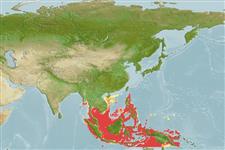Environment: milieu / climate zone / depth range / distribution range
Écologie
marin; eau douce; saumâtre démersal. Tropical; 22°C - 28°C (Ref. 12468); 21°N - 11°S, 94°E - 152°E
Indo-West Pacific: Indonesia, New Guinea, and the Philippines. Reports from Japan are erroneous.
Taille / Poids / Âge
Maturity: Lm ? range ? - ? cm
Max length : 10.0 cm TL mâle / non sexé; (Ref. 7050)
Épines dorsales (Total) : 13 - 14; Épines anales: 3. Body notably compressed. Orbit 9 - 10% SL. Dorsal soft rays 6.5-7.5; anal 4.5 (usually) to 5.5 (Ref. 39597).
Possesses venom glands at the base of some of the spines (Ref. 6192). Of no commercial interest but appear from time to time in the aquarium trade (Ref. 39597).
Life cycle and mating behavior
Maturité | Reproduction | Frai | Œufs | Fécondité | Larves
Kailola, P.J., 1987. The fishes of Papua New Guinea: a revised and annotated checklist. Vol. II Scorpaenidae to Callionymidae. Research Bulletin No. 41, Research Section, Dept. of Fisheries and Marine Resources, Papua New Guinea. (Ref. 6192)
Statut dans la liste rouge de l'IUCN (Ref. 130435: Version 2024-1)
Menace pour l'homme
Venomous
Utilisations par l'homme
Pêcheries: sans intérêt
Outils
Articles particuliers
Télécharger en XML
Sources Internet
Estimates based on models
Preferred temperature (Ref.
123201): 20.4 - 28.1, mean 26.1 °C (based on 122 cells).
Phylogenetic diversity index (Ref.
82804): PD
50 = 1.0000 [Uniqueness, from 0.5 = low to 2.0 = high].
Bayesian length-weight: a=0.01905 (0.00776 - 0.04678), b=3.03 (2.82 - 3.24), in cm total length, based on LWR estimates for this (Sub)family-body shape (Ref.
93245).
Niveau trophique (Ref.
69278): 3.2 ±0.3 se; based on size and trophs of closest relatives
Résilience (Ref.
120179): Milieu, temps minimum de doublement de population : 1,4 à 4,4 années (Preliminary K or Fecundity.).
Fishing Vulnerability (Ref.
59153): Low vulnerability (10 of 100).
